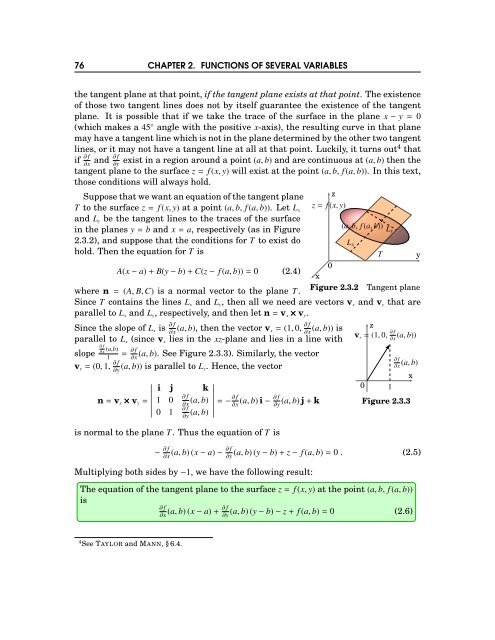Michael Corral: Vector Calculus
Michael Corral: Vector Calculus
Michael Corral: Vector Calculus
Create successful ePaper yourself
Turn your PDF publications into a flip-book with our unique Google optimized e-Paper software.
76 CHAPTER 2. FUNCTIONS OF SEVERAL VARIABLES<br />
the tangent plane at that point, if the tangent plane exists at that point. The existence<br />
of those two tangent lines does not by itself guarantee the existence of the tangent<br />
plane. It is possible that if we take the trace of the surface in the plane x−y=0<br />
(which makes a 45 ◦ angle with the positive x-axis), the resulting curve in that plane<br />
mayhaveatangentlinewhichisnotintheplanedeterminedbytheothertwotangent<br />
lines, or it may not have a tangent line at all at that point. Luckily, it turns out 4 that<br />
if ∂f ∂f<br />
∂x<br />
and<br />
∂y<br />
exist in a region around a point (a,b) and are continuous at (a,b) then the<br />
tangent plane to the surface z= f(x,y) will exist at the point (a,b, f(a,b)). In this text,<br />
those conditions will always hold.<br />
Supposethatwewantanequationofthetangentplane<br />
T to the surface z= f(x,y) at a point (a,b, f(a,b)). Let L x<br />
and L y be the tangent lines to the traces of the surface<br />
in the planes y=band x=a, respectively (as in Figure<br />
2.3.2), and suppose that the conditions for T to exist do<br />
hold. Then the equation for T is<br />
z<br />
z= f(x,y)<br />
(a,b, f(a,b))<br />
T y<br />
0<br />
A(x−a)+ B(y−b)+C(z− f(a,b))=0 (2.4)<br />
x<br />
where n=(A,B,C) is a normal vector to the plane T.<br />
Figure 2.3.2 Tangent plane<br />
Since T contains the lines L x and L y , then all we need are vectors v x and v y that are<br />
parallel to L x and L y , respectively, and then let n=v x ×v y .<br />
Since the slope of L x is ∂f<br />
∂x (a,b), then the vector v x= (1,0, ∂f<br />
∂x<br />
(a,b)) is<br />
parallel to L x (since v x lies in the xz-plane and lies in a line with<br />
slope ∂f<br />
∂x (a,b)<br />
(a,b). See Figure 2.3.3). Similarly, the vector<br />
v y = (0,1, ∂f<br />
∂y (a,b)) is parallel to L y. Hence, the vector<br />
1<br />
= ∂f<br />
∂x<br />
i j<br />
n=v x ×v y =<br />
1 0<br />
∣ 0 1<br />
∣<br />
k ∣∣∣∣∣∣∣∣<br />
∂f<br />
∂x (a,b) =− ∂f<br />
∂f<br />
∂y (a,b) ∂x (a,b)i−∂f ∂y (a,b)j+k<br />
is normal to the plane T. Thus the equation of T is<br />
− ∂f<br />
L x<br />
L y<br />
z<br />
v x = (1,0, ∂f<br />
∂x (a,b))<br />
0<br />
1<br />
∂f<br />
∂x (a,b)<br />
Figure 2.3.3<br />
∂x (a,b)(x−a)−∂f ∂y<br />
(a,b)(y−b)+z− f(a,b)=0. (2.5)<br />
Multiplying both sides by−1, we have the following result:<br />
The equation of the tangent plane to the surface z= f(x,y) at the point (a,b, f(a,b))<br />
is<br />
∂f<br />
∂x (a,b)(x−a)+∂f ∂y<br />
(a,b)(y−b)−z+ f(a,b)=0 (2.6)<br />
x<br />
4 See TAYLOR and MANN, §6.4.








